A Comprehensive Report on TESCO's International Marketing Strategies
VerifiedAdded on 2020/06/06
|9
|2203
|42
Report
AI Summary
This report provides a comprehensive analysis of TESCO's international marketing strategies. It begins with an introduction to international marketing, emphasizing its role in global business expansion, and then focuses on TESCO's approach. The report delves into TESCO's marketing mix, covering product, price, place, promotion, people, process, and physical evidence, and how these elements contribute to the company's success. It further examines TESCO's market entry strategies, including exporting, licensing, and franchising, and discusses the factors that impact these strategies, such as technological, political, market, and cost drivers. The report also explores international market theories, particularly the concept of comparative advantage, and its significance for TESCO's business operations. The conclusion summarizes the key findings, highlighting the importance of analyzing challenges and developing effective business plans to achieve international marketing objectives. The report references key marketing theories and provides insights into TESCO's strategic decisions in the global market.
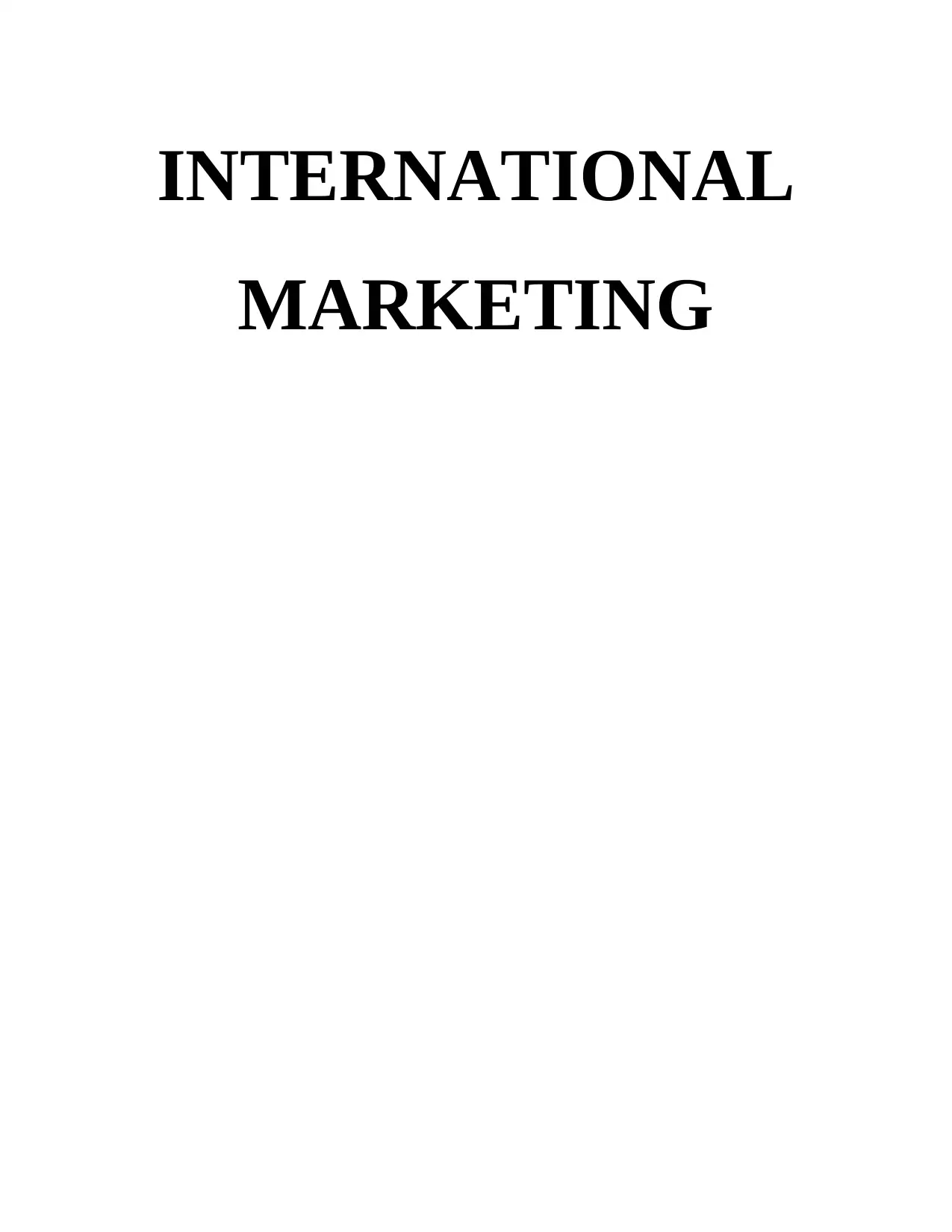
INTERNATIONAL
MARKETING
MARKETING
Paraphrase This Document
Need a fresh take? Get an instant paraphrase of this document with our AI Paraphraser
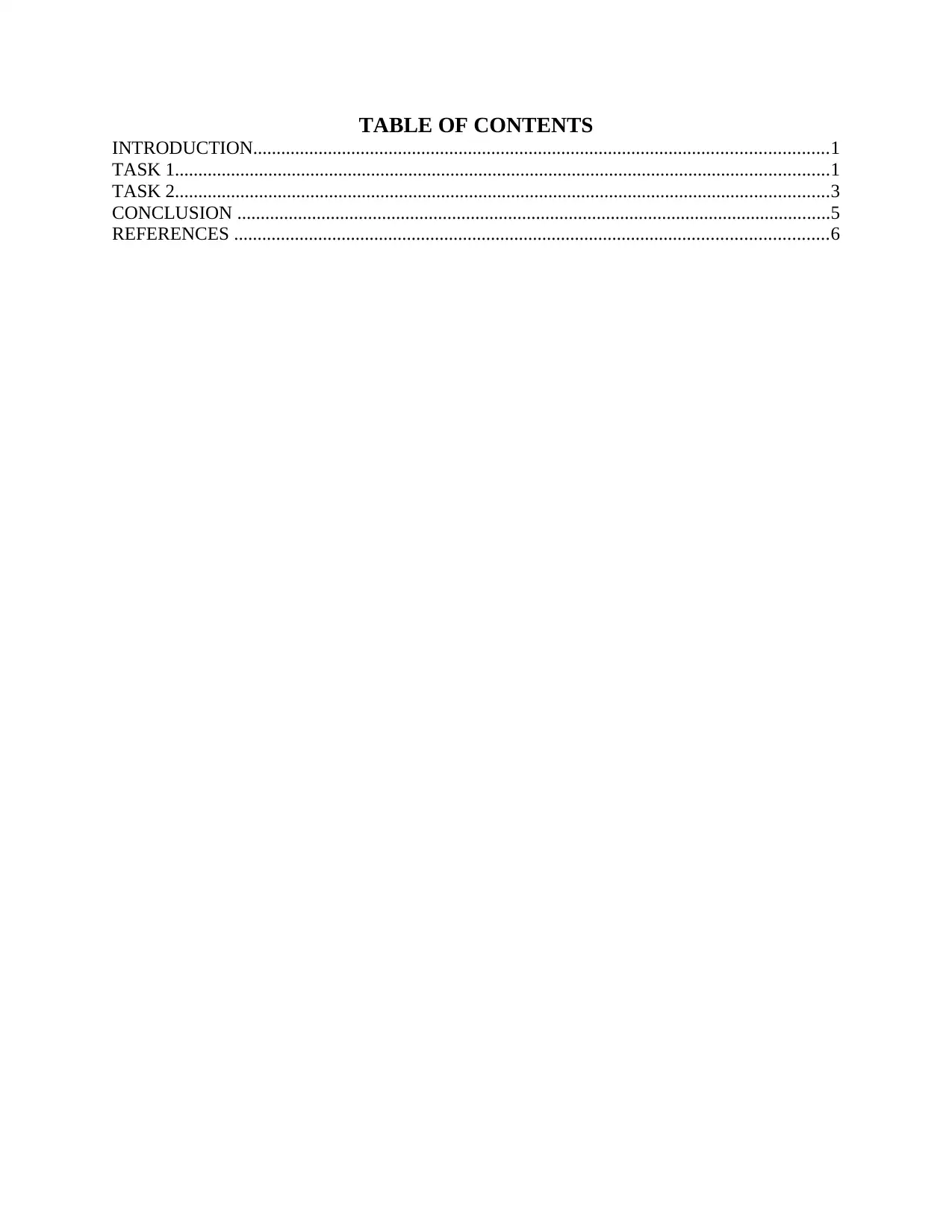
TABLE OF CONTENTS
INTRODUCTION...........................................................................................................................1
TASK 1............................................................................................................................................1
TASK 2............................................................................................................................................3
CONCLUSION ...............................................................................................................................5
REFERENCES ...............................................................................................................................6
INTRODUCTION...........................................................................................................................1
TASK 1............................................................................................................................................1
TASK 2............................................................................................................................................3
CONCLUSION ...............................................................................................................................5
REFERENCES ...............................................................................................................................6
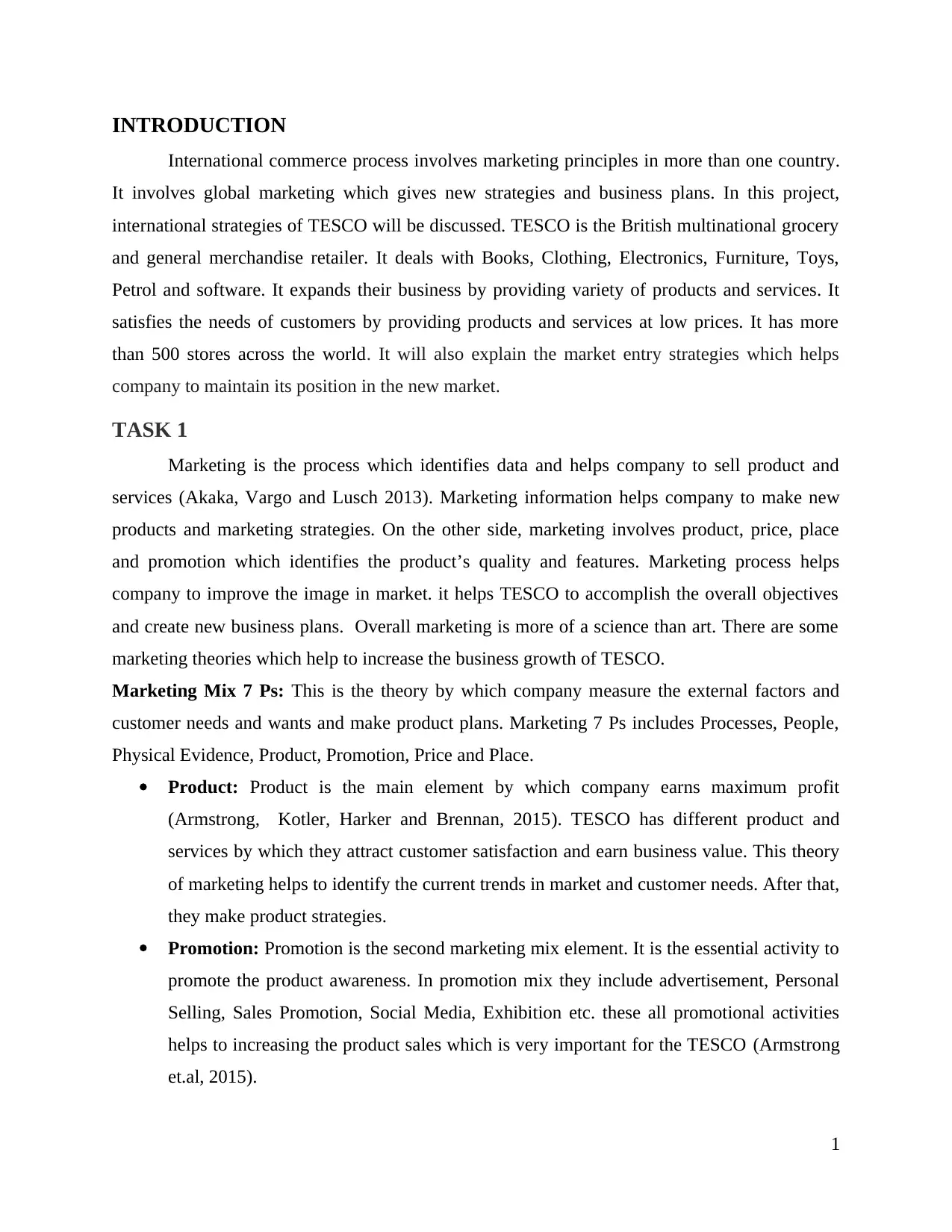
INTRODUCTION
International commerce process involves marketing principles in more than one country.
It involves global marketing which gives new strategies and business plans. In this project,
international strategies of TESCO will be discussed. TESCO is the British multinational grocery
and general merchandise retailer. It deals with Books, Clothing, Electronics, Furniture, Toys,
Petrol and software. It expands their business by providing variety of products and services. It
satisfies the needs of customers by providing products and services at low prices. It has more
than 500 stores across the world. It will also explain the market entry strategies which helps
company to maintain its position in the new market.
TASK 1
Marketing is the process which identifies data and helps company to sell product and
services (Akaka, Vargo and Lusch 2013). Marketing information helps company to make new
products and marketing strategies. On the other side, marketing involves product, price, place
and promotion which identifies the product’s quality and features. Marketing process helps
company to improve the image in market. it helps TESCO to accomplish the overall objectives
and create new business plans. Overall marketing is more of a science than art. There are some
marketing theories which help to increase the business growth of TESCO.
Marketing Mix 7 Ps: This is the theory by which company measure the external factors and
customer needs and wants and make product plans. Marketing 7 Ps includes Processes, People,
Physical Evidence, Product, Promotion, Price and Place.
Product: Product is the main element by which company earns maximum profit
(Armstrong, Kotler, Harker and Brennan, 2015). TESCO has different product and
services by which they attract customer satisfaction and earn business value. This theory
of marketing helps to identify the current trends in market and customer needs. After that,
they make product strategies.
Promotion: Promotion is the second marketing mix element. It is the essential activity to
promote the product awareness. In promotion mix they include advertisement, Personal
Selling, Sales Promotion, Social Media, Exhibition etc. these all promotional activities
helps to increasing the product sales which is very important for the TESCO (Armstrong
et.al, 2015).
1
International commerce process involves marketing principles in more than one country.
It involves global marketing which gives new strategies and business plans. In this project,
international strategies of TESCO will be discussed. TESCO is the British multinational grocery
and general merchandise retailer. It deals with Books, Clothing, Electronics, Furniture, Toys,
Petrol and software. It expands their business by providing variety of products and services. It
satisfies the needs of customers by providing products and services at low prices. It has more
than 500 stores across the world. It will also explain the market entry strategies which helps
company to maintain its position in the new market.
TASK 1
Marketing is the process which identifies data and helps company to sell product and
services (Akaka, Vargo and Lusch 2013). Marketing information helps company to make new
products and marketing strategies. On the other side, marketing involves product, price, place
and promotion which identifies the product’s quality and features. Marketing process helps
company to improve the image in market. it helps TESCO to accomplish the overall objectives
and create new business plans. Overall marketing is more of a science than art. There are some
marketing theories which help to increase the business growth of TESCO.
Marketing Mix 7 Ps: This is the theory by which company measure the external factors and
customer needs and wants and make product plans. Marketing 7 Ps includes Processes, People,
Physical Evidence, Product, Promotion, Price and Place.
Product: Product is the main element by which company earns maximum profit
(Armstrong, Kotler, Harker and Brennan, 2015). TESCO has different product and
services by which they attract customer satisfaction and earn business value. This theory
of marketing helps to identify the current trends in market and customer needs. After that,
they make product strategies.
Promotion: Promotion is the second marketing mix element. It is the essential activity to
promote the product awareness. In promotion mix they include advertisement, Personal
Selling, Sales Promotion, Social Media, Exhibition etc. these all promotional activities
helps to increasing the product sales which is very important for the TESCO (Armstrong
et.al, 2015).
1
⊘ This is a preview!⊘
Do you want full access?
Subscribe today to unlock all pages.

Trusted by 1+ million students worldwide
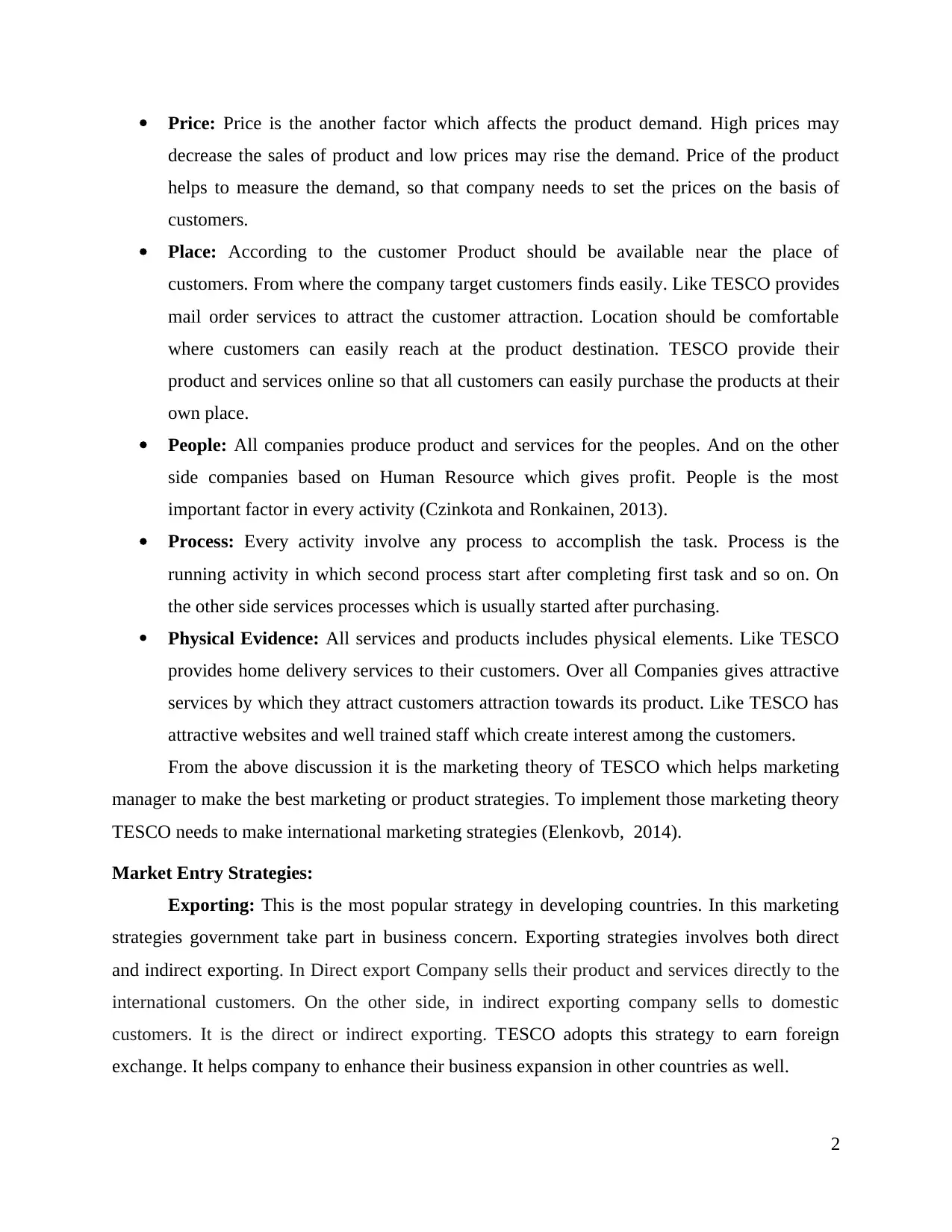
Price: Price is the another factor which affects the product demand. High prices may
decrease the sales of product and low prices may rise the demand. Price of the product
helps to measure the demand, so that company needs to set the prices on the basis of
customers.
Place: According to the customer Product should be available near the place of
customers. From where the company target customers finds easily. Like TESCO provides
mail order services to attract the customer attraction. Location should be comfortable
where customers can easily reach at the product destination. TESCO provide their
product and services online so that all customers can easily purchase the products at their
own place.
People: All companies produce product and services for the peoples. And on the other
side companies based on Human Resource which gives profit. People is the most
important factor in every activity (Czinkota and Ronkainen, 2013).
Process: Every activity involve any process to accomplish the task. Process is the
running activity in which second process start after completing first task and so on. On
the other side services processes which is usually started after purchasing.
Physical Evidence: All services and products includes physical elements. Like TESCO
provides home delivery services to their customers. Over all Companies gives attractive
services by which they attract customers attraction towards its product. Like TESCO has
attractive websites and well trained staff which create interest among the customers.
From the above discussion it is the marketing theory of TESCO which helps marketing
manager to make the best marketing or product strategies. To implement those marketing theory
TESCO needs to make international marketing strategies (Elenkovb, 2014).
Market Entry Strategies:
Exporting: This is the most popular strategy in developing countries. In this marketing
strategies government take part in business concern. Exporting strategies involves both direct
and indirect exporting. In Direct export Company sells their product and services directly to the
international customers. On the other side, in indirect exporting company sells to domestic
customers. It is the direct or indirect exporting. TESCO adopts this strategy to earn foreign
exchange. It helps company to enhance their business expansion in other countries as well.
2
decrease the sales of product and low prices may rise the demand. Price of the product
helps to measure the demand, so that company needs to set the prices on the basis of
customers.
Place: According to the customer Product should be available near the place of
customers. From where the company target customers finds easily. Like TESCO provides
mail order services to attract the customer attraction. Location should be comfortable
where customers can easily reach at the product destination. TESCO provide their
product and services online so that all customers can easily purchase the products at their
own place.
People: All companies produce product and services for the peoples. And on the other
side companies based on Human Resource which gives profit. People is the most
important factor in every activity (Czinkota and Ronkainen, 2013).
Process: Every activity involve any process to accomplish the task. Process is the
running activity in which second process start after completing first task and so on. On
the other side services processes which is usually started after purchasing.
Physical Evidence: All services and products includes physical elements. Like TESCO
provides home delivery services to their customers. Over all Companies gives attractive
services by which they attract customers attraction towards its product. Like TESCO has
attractive websites and well trained staff which create interest among the customers.
From the above discussion it is the marketing theory of TESCO which helps marketing
manager to make the best marketing or product strategies. To implement those marketing theory
TESCO needs to make international marketing strategies (Elenkovb, 2014).
Market Entry Strategies:
Exporting: This is the most popular strategy in developing countries. In this marketing
strategies government take part in business concern. Exporting strategies involves both direct
and indirect exporting. In Direct export Company sells their product and services directly to the
international customers. On the other side, in indirect exporting company sells to domestic
customers. It is the direct or indirect exporting. TESCO adopts this strategy to earn foreign
exchange. It helps company to enhance their business expansion in other countries as well.
2
Paraphrase This Document
Need a fresh take? Get an instant paraphrase of this document with our AI Paraphraser
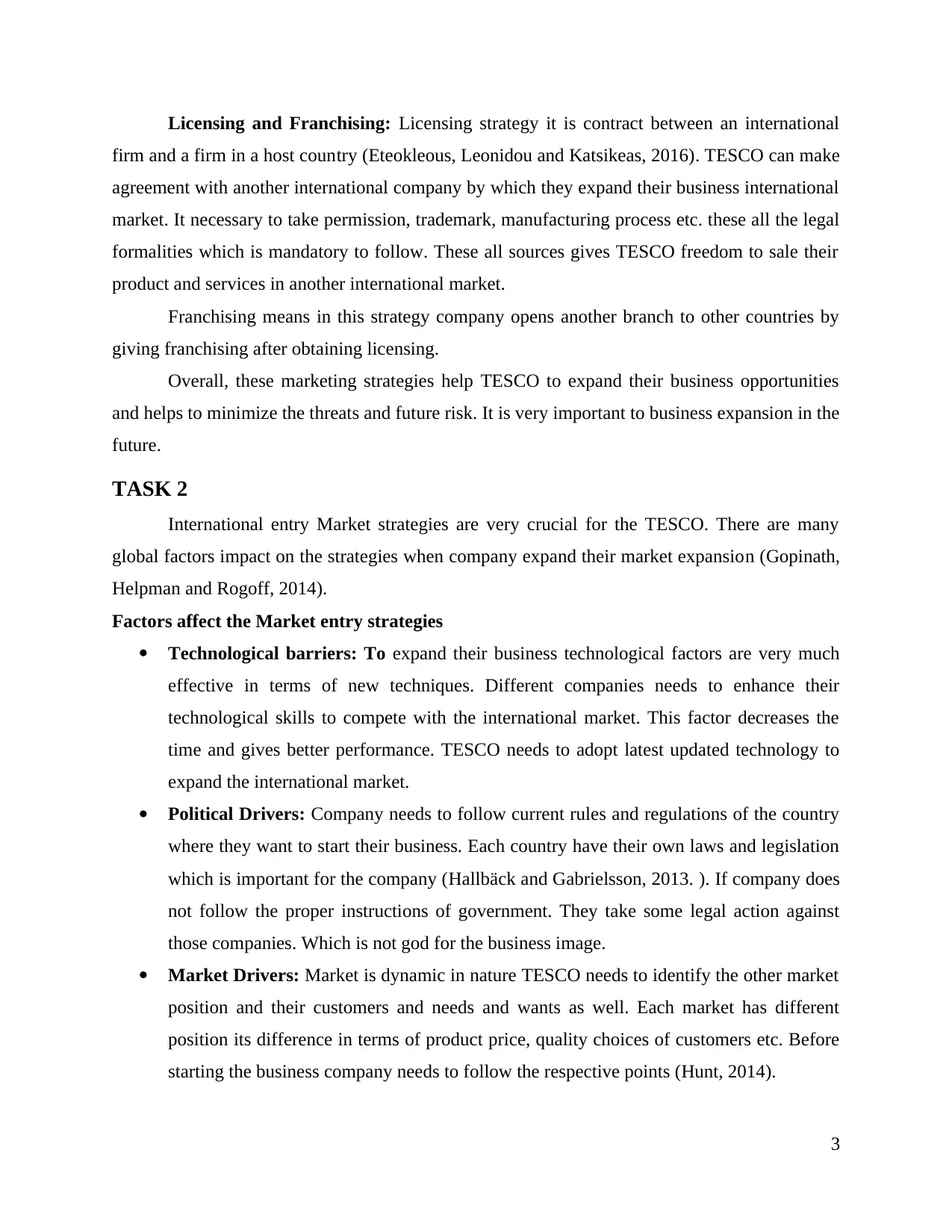
Licensing and Franchising: Licensing strategy it is contract between an international
firm and a firm in a host country (Eteokleous, Leonidou and Katsikeas, 2016). TESCO can make
agreement with another international company by which they expand their business international
market. It necessary to take permission, trademark, manufacturing process etc. these all the legal
formalities which is mandatory to follow. These all sources gives TESCO freedom to sale their
product and services in another international market.
Franchising means in this strategy company opens another branch to other countries by
giving franchising after obtaining licensing.
Overall, these marketing strategies help TESCO to expand their business opportunities
and helps to minimize the threats and future risk. It is very important to business expansion in the
future.
TASK 2
International entry Market strategies are very crucial for the TESCO. There are many
global factors impact on the strategies when company expand their market expansion (Gopinath,
Helpman and Rogoff, 2014).
Factors affect the Market entry strategies
Technological barriers: To expand their business technological factors are very much
effective in terms of new techniques. Different companies needs to enhance their
technological skills to compete with the international market. This factor decreases the
time and gives better performance. TESCO needs to adopt latest updated technology to
expand the international market.
Political Drivers: Company needs to follow current rules and regulations of the country
where they want to start their business. Each country have their own laws and legislation
which is important for the company (Hallbäck and Gabrielsson, 2013. ). If company does
not follow the proper instructions of government. They take some legal action against
those companies. Which is not god for the business image.
Market Drivers: Market is dynamic in nature TESCO needs to identify the other market
position and their customers and needs and wants as well. Each market has different
position its difference in terms of product price, quality choices of customers etc. Before
starting the business company needs to follow the respective points (Hunt, 2014).
3
firm and a firm in a host country (Eteokleous, Leonidou and Katsikeas, 2016). TESCO can make
agreement with another international company by which they expand their business international
market. It necessary to take permission, trademark, manufacturing process etc. these all the legal
formalities which is mandatory to follow. These all sources gives TESCO freedom to sale their
product and services in another international market.
Franchising means in this strategy company opens another branch to other countries by
giving franchising after obtaining licensing.
Overall, these marketing strategies help TESCO to expand their business opportunities
and helps to minimize the threats and future risk. It is very important to business expansion in the
future.
TASK 2
International entry Market strategies are very crucial for the TESCO. There are many
global factors impact on the strategies when company expand their market expansion (Gopinath,
Helpman and Rogoff, 2014).
Factors affect the Market entry strategies
Technological barriers: To expand their business technological factors are very much
effective in terms of new techniques. Different companies needs to enhance their
technological skills to compete with the international market. This factor decreases the
time and gives better performance. TESCO needs to adopt latest updated technology to
expand the international market.
Political Drivers: Company needs to follow current rules and regulations of the country
where they want to start their business. Each country have their own laws and legislation
which is important for the company (Hallbäck and Gabrielsson, 2013. ). If company does
not follow the proper instructions of government. They take some legal action against
those companies. Which is not god for the business image.
Market Drivers: Market is dynamic in nature TESCO needs to identify the other market
position and their customers and needs and wants as well. Each market has different
position its difference in terms of product price, quality choices of customers etc. Before
starting the business company needs to follow the respective points (Hunt, 2014).
3
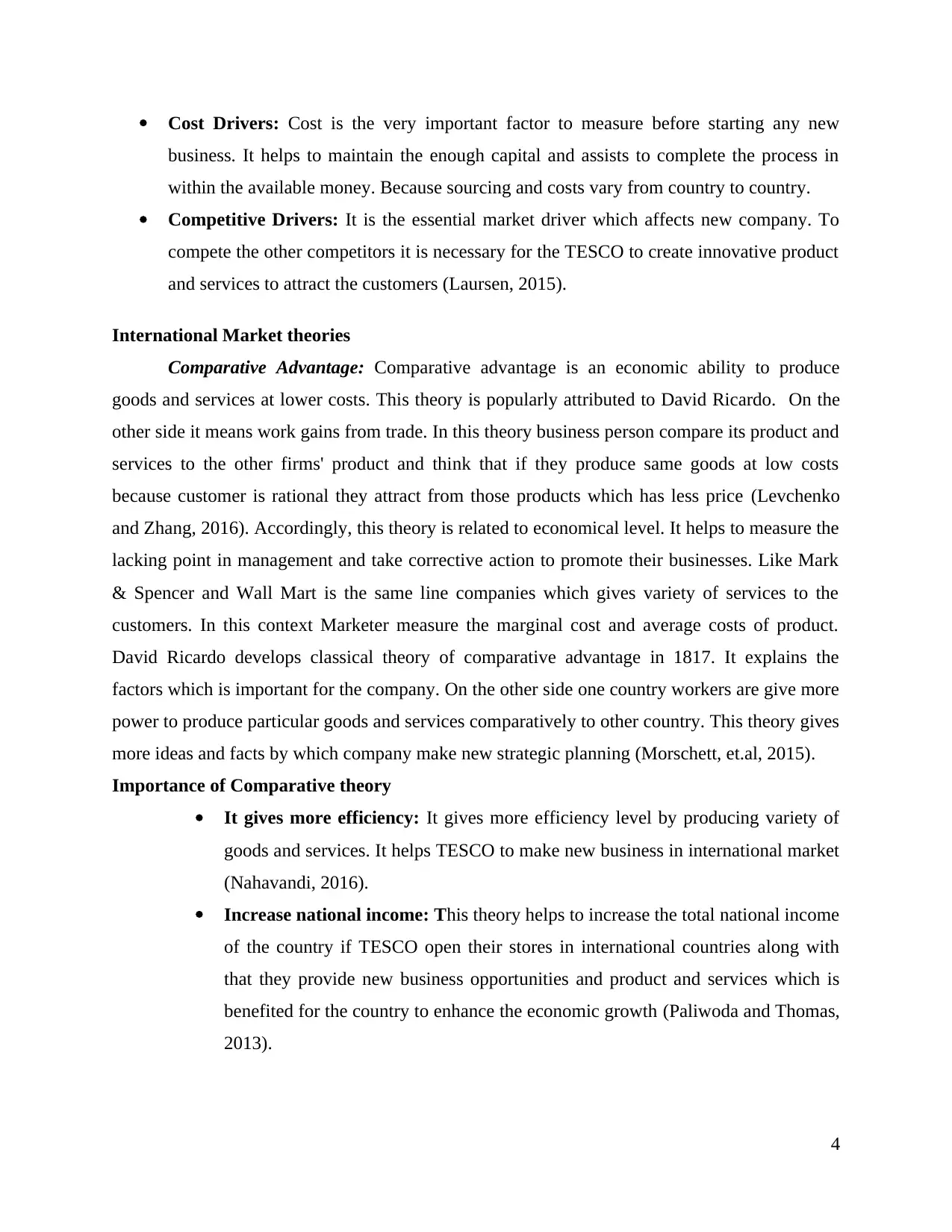
Cost Drivers: Cost is the very important factor to measure before starting any new
business. It helps to maintain the enough capital and assists to complete the process in
within the available money. Because sourcing and costs vary from country to country.
Competitive Drivers: It is the essential market driver which affects new company. To
compete the other competitors it is necessary for the TESCO to create innovative product
and services to attract the customers (Laursen, 2015).
International Market theories
Comparative Advantage: Comparative advantage is an economic ability to produce
goods and services at lower costs. This theory is popularly attributed to David Ricardo. On the
other side it means work gains from trade. In this theory business person compare its product and
services to the other firms' product and think that if they produce same goods at low costs
because customer is rational they attract from those products which has less price (Levchenko
and Zhang, 2016). Accordingly, this theory is related to economical level. It helps to measure the
lacking point in management and take corrective action to promote their businesses. Like Mark
& Spencer and Wall Mart is the same line companies which gives variety of services to the
customers. In this context Marketer measure the marginal cost and average costs of product.
David Ricardo develops classical theory of comparative advantage in 1817. It explains the
factors which is important for the company. On the other side one country workers are give more
power to produce particular goods and services comparatively to other country. This theory gives
more ideas and facts by which company make new strategic planning (Morschett, et.al, 2015).
Importance of Comparative theory
It gives more efficiency: It gives more efficiency level by producing variety of
goods and services. It helps TESCO to make new business in international market
(Nahavandi, 2016).
Increase national income: This theory helps to increase the total national income
of the country if TESCO open their stores in international countries along with
that they provide new business opportunities and product and services which is
benefited for the country to enhance the economic growth (Paliwoda and Thomas,
2013).
4
business. It helps to maintain the enough capital and assists to complete the process in
within the available money. Because sourcing and costs vary from country to country.
Competitive Drivers: It is the essential market driver which affects new company. To
compete the other competitors it is necessary for the TESCO to create innovative product
and services to attract the customers (Laursen, 2015).
International Market theories
Comparative Advantage: Comparative advantage is an economic ability to produce
goods and services at lower costs. This theory is popularly attributed to David Ricardo. On the
other side it means work gains from trade. In this theory business person compare its product and
services to the other firms' product and think that if they produce same goods at low costs
because customer is rational they attract from those products which has less price (Levchenko
and Zhang, 2016). Accordingly, this theory is related to economical level. It helps to measure the
lacking point in management and take corrective action to promote their businesses. Like Mark
& Spencer and Wall Mart is the same line companies which gives variety of services to the
customers. In this context Marketer measure the marginal cost and average costs of product.
David Ricardo develops classical theory of comparative advantage in 1817. It explains the
factors which is important for the company. On the other side one country workers are give more
power to produce particular goods and services comparatively to other country. This theory gives
more ideas and facts by which company make new strategic planning (Morschett, et.al, 2015).
Importance of Comparative theory
It gives more efficiency: It gives more efficiency level by producing variety of
goods and services. It helps TESCO to make new business in international market
(Nahavandi, 2016).
Increase national income: This theory helps to increase the total national income
of the country if TESCO open their stores in international countries along with
that they provide new business opportunities and product and services which is
benefited for the country to enhance the economic growth (Paliwoda and Thomas,
2013).
4
⊘ This is a preview!⊘
Do you want full access?
Subscribe today to unlock all pages.

Trusted by 1+ million students worldwide

New Product and services: This model of theory compares various factors
before starting the business which helps to open new market services for the
customers (Papadopoulos and Heslp, 2014).
Reducing operational Costs: It also helps to minimize the expenses and
unwanted costs which involves in the operational activities.
Overall this model is very fruitful to measure the international market and earn
maximum profit (Turnbull and eds., 2013).
CONCLUSION
From the above discussion it concludes the international marketing strategies of TESCO
and their different market entry strategies as well. Adding to that market theories through which
TESCO apply those strategies more effectively. Furthermore, it was explained about the impacts
of globalisation on market entry. Overall TESCO needs to analyse the different challenging
factors and make the best business plans to accomplish the business objectives and make their
plan more effectively to attract new potential customers.
5
before starting the business which helps to open new market services for the
customers (Papadopoulos and Heslp, 2014).
Reducing operational Costs: It also helps to minimize the expenses and
unwanted costs which involves in the operational activities.
Overall this model is very fruitful to measure the international market and earn
maximum profit (Turnbull and eds., 2013).
CONCLUSION
From the above discussion it concludes the international marketing strategies of TESCO
and their different market entry strategies as well. Adding to that market theories through which
TESCO apply those strategies more effectively. Furthermore, it was explained about the impacts
of globalisation on market entry. Overall TESCO needs to analyse the different challenging
factors and make the best business plans to accomplish the business objectives and make their
plan more effectively to attract new potential customers.
5
Paraphrase This Document
Need a fresh take? Get an instant paraphrase of this document with our AI Paraphraser

REFERENCES
Akaka, M. A., Vargo, S. L. and Lusch, R. F., 2013. The complexity of context: A service
ecosystems approach for international marketing. Journal of Marketing Research.21(4). pp.1-20.
Armstrong, G., Kotler, P., Harker, M. and Brennan, R., 2015. Marketing: an introduction.
Pearson Education.
Armstrong, et.al, 2015. Marketing: an introduction. Pearson Education.
Czinkota, M. R. and Ronkainen, I. A., 2013. International marketing. Cengage Learning.
Elenkov, D., 2014. Experiential Exercise with Multinational Student Teams: Researching
Together a Multinational Corporation and Developing Jointly a Strategic Marketing Plan for IT
Using Blackboard. Developments in Business Simulation and Experiential Learning. 41.
Eteokleous, P. P., Leonidou, L. C. and Katsikeas, C. S., 2016. Corporate social
responsibility in international marketing: review, assessment, and future research. International
Marketing Review. 33(4). pp.580-624.
Gopinath, G., Helpman, E. and Rogoff, K. eds., 2014. Handbook of international
economics (Vol. 4). Elsevier.
Grubel, H. G., 2014. A theory of multinational banking. PSL Quarterly Review. 30(123).
Hallbäck, J. and Gabrielsson, P., 2013. Entrepreneurial marketing strategies during the
growth of international new ventures originating in small and open economies. International
Business Review. 22(6). pp.1008-1020.
Hunt, S. D., 2014. Marketing theory: foundations, controversy, strategy, and resource-
advantage theory. Routledge.
Laursen, K., 2015. Revealed comparative advantage and the alternatives as measures of
international specialization. Eurasian Business Review. 5(1). pp.99-115.
Levchenko, A. A. and Zhang, J., 2016. The evolution of comparative advantage:
Measurement and welfare implications. Journal of Monetary Economics. 78. pp.96-111.
Morschett, et.al, 2015. Strategic international management. Springer.
Nahavandi, A., 2016. The Art and Science of Leadership -Global Edition. Pearson.
6
Akaka, M. A., Vargo, S. L. and Lusch, R. F., 2013. The complexity of context: A service
ecosystems approach for international marketing. Journal of Marketing Research.21(4). pp.1-20.
Armstrong, G., Kotler, P., Harker, M. and Brennan, R., 2015. Marketing: an introduction.
Pearson Education.
Armstrong, et.al, 2015. Marketing: an introduction. Pearson Education.
Czinkota, M. R. and Ronkainen, I. A., 2013. International marketing. Cengage Learning.
Elenkov, D., 2014. Experiential Exercise with Multinational Student Teams: Researching
Together a Multinational Corporation and Developing Jointly a Strategic Marketing Plan for IT
Using Blackboard. Developments in Business Simulation and Experiential Learning. 41.
Eteokleous, P. P., Leonidou, L. C. and Katsikeas, C. S., 2016. Corporate social
responsibility in international marketing: review, assessment, and future research. International
Marketing Review. 33(4). pp.580-624.
Gopinath, G., Helpman, E. and Rogoff, K. eds., 2014. Handbook of international
economics (Vol. 4). Elsevier.
Grubel, H. G., 2014. A theory of multinational banking. PSL Quarterly Review. 30(123).
Hallbäck, J. and Gabrielsson, P., 2013. Entrepreneurial marketing strategies during the
growth of international new ventures originating in small and open economies. International
Business Review. 22(6). pp.1008-1020.
Hunt, S. D., 2014. Marketing theory: foundations, controversy, strategy, and resource-
advantage theory. Routledge.
Laursen, K., 2015. Revealed comparative advantage and the alternatives as measures of
international specialization. Eurasian Business Review. 5(1). pp.99-115.
Levchenko, A. A. and Zhang, J., 2016. The evolution of comparative advantage:
Measurement and welfare implications. Journal of Monetary Economics. 78. pp.96-111.
Morschett, et.al, 2015. Strategic international management. Springer.
Nahavandi, A., 2016. The Art and Science of Leadership -Global Edition. Pearson.
6
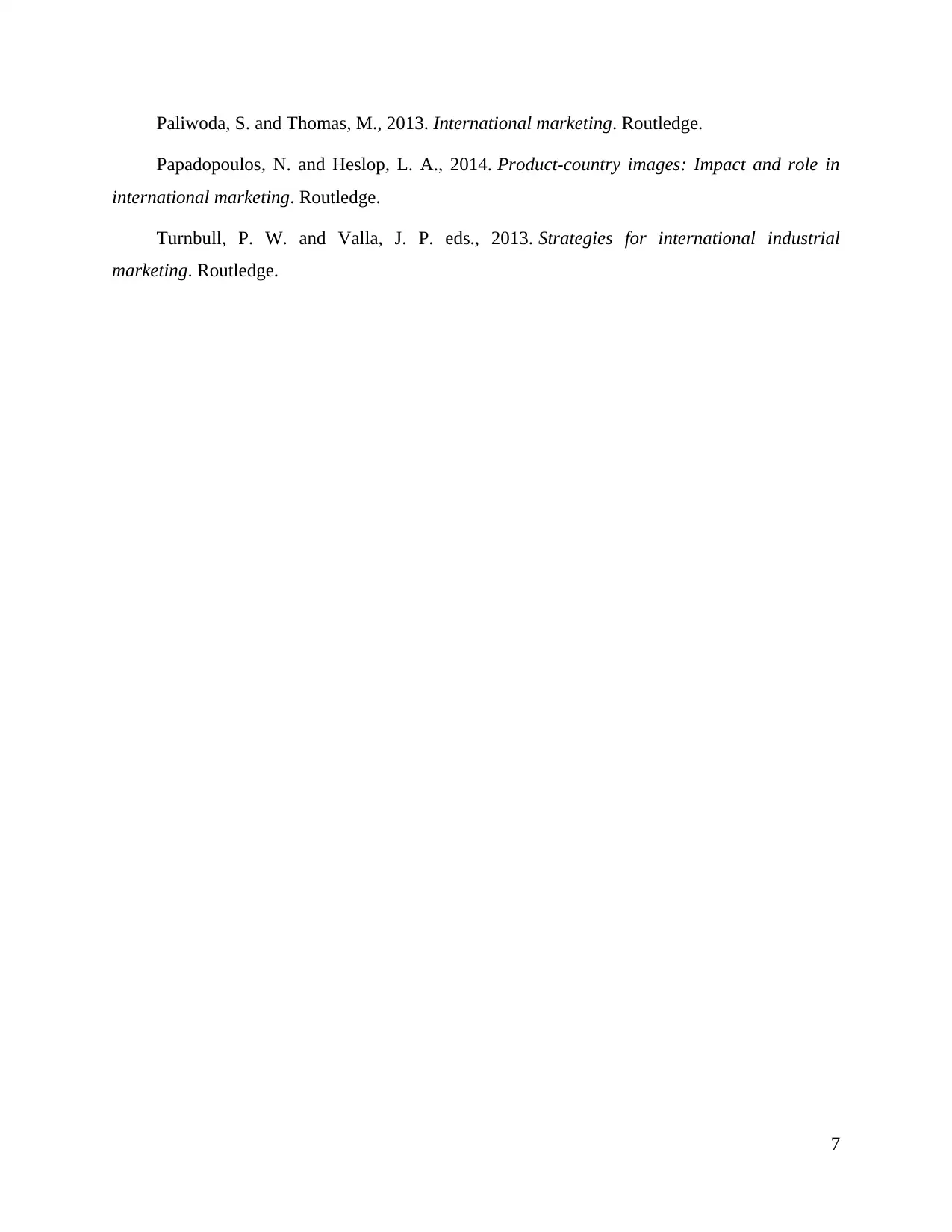
Paliwoda, S. and Thomas, M., 2013. International marketing. Routledge.
Papadopoulos, N. and Heslop, L. A., 2014. Product-country images: Impact and role in
international marketing. Routledge.
Turnbull, P. W. and Valla, J. P. eds., 2013. Strategies for international industrial
marketing. Routledge.
7
Papadopoulos, N. and Heslop, L. A., 2014. Product-country images: Impact and role in
international marketing. Routledge.
Turnbull, P. W. and Valla, J. P. eds., 2013. Strategies for international industrial
marketing. Routledge.
7
⊘ This is a preview!⊘
Do you want full access?
Subscribe today to unlock all pages.

Trusted by 1+ million students worldwide
1 out of 9
Related Documents
Your All-in-One AI-Powered Toolkit for Academic Success.
+13062052269
info@desklib.com
Available 24*7 on WhatsApp / Email
![[object Object]](/_next/static/media/star-bottom.7253800d.svg)
Unlock your academic potential
Copyright © 2020–2025 A2Z Services. All Rights Reserved. Developed and managed by ZUCOL.




